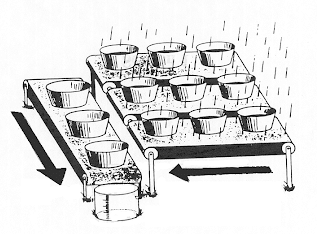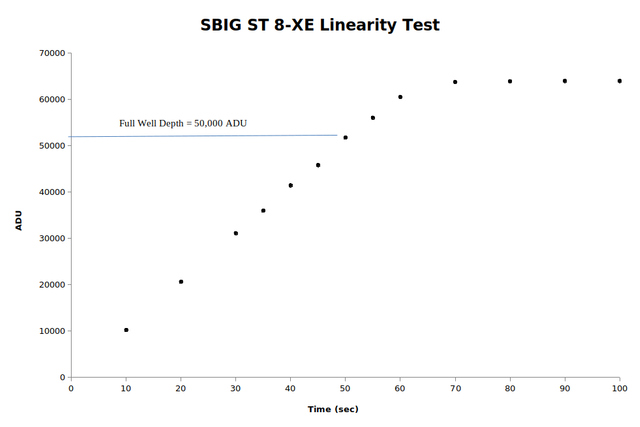Linearity testing

Each pixel of a CCD sensor is like a bucket, but instead of collecting rain water, these buckets collect electrons that are generated by the incoming photons. Just like a bucket can only hold a finite volume of water, a pixel can only collect a finite number of electrons before it "overflows." When the bucket overflows, the measurement of the electrons is no longer linear. What does that mean? Consider in the water example, a certain number of rain drops will produce a certain change in volume of the amount of water in the bucket. This relationship holds up to the point where the bucket overflows and the incoming rain drops cannot be measured because all of the space has been taken up. The same is true for pixels in the CCD sensor: There is a linear response between the amount of incoming photons and the measured number of electrons per pixel up to a certain point where the relationship breaks down and the pixel "overflows" or "blooms" (see Figure 2 below).

Some types of CCD sensors have what is called an Anti-Blooming Gate (ABG) to try to minimize the effects of blooming. However, since photometry is concerned with precise counting of the number of photons, it is better, but not absolutely necessary, to have a Non Anti Blooming Gate (NABG) to get an unadulterated measurement. The manufacturer's CCD specifications will include the Full Well Depth of the sensor, or the expected number of electrons that can be collected before the pixels bloom. In either case (ABG or NABG), it is best practice to actually test the camera to find out where the pixels saturate and if there is any non-linear behavior before the point of saturation. This will enable better photometry since the "overflow" point is well established and can be avoided.

The sensor clearly saturates at just over 60,000 ADU (Analog to digital units). However, after fitting a straight line to the data, there also appears to be some non-linear behavior before the point of saturation. It is not entirely clear from this data exactly where the linearity ends, but a reasonable estimate is about 50,000 ADU. This is a "deeper" full well depth than reported by the CCD manufacturer (SBIG). However, it is probably best that their estimate is conservative. In fact, it is smart to use the more conservative number to calculate exposure times for the targets of interest. For example, if the goal was to expose a target until it reaches half of its full well depth (a typical practice in photometry), it would be wise to use 40,000/2 = 20,000 ADU. When in the business of counting photons, it is always safer to err on the side of under-exposure in order to maintain the all important linear relationship between the incoming light and measured electrons.
References
- AOweb: http://astronomyonline.org/astrophotography/ccd.asp
- Howell, S. B. 2006, Handbook of CCD Astronomy, Cambridge University Press, UK
This post has been voted on by the SteemSTEM curation team and voting trail in collaboration with @curie.
If you appreciate the work we are doing then consider voting both projects for witness by selecting stem.witness and curie!
For additional information please join us on the SteemSTEM discord and to get to know the rest of the community!
It's tricky for all kinds of equipment... For my colleagues (biology), always check the specs of your camera system if you want to do some sort of quantification. This is the reason why.